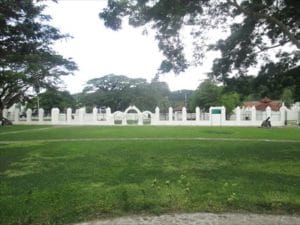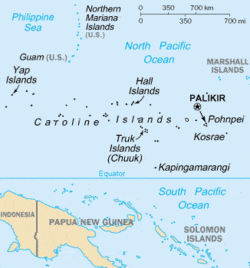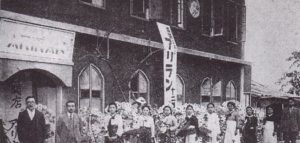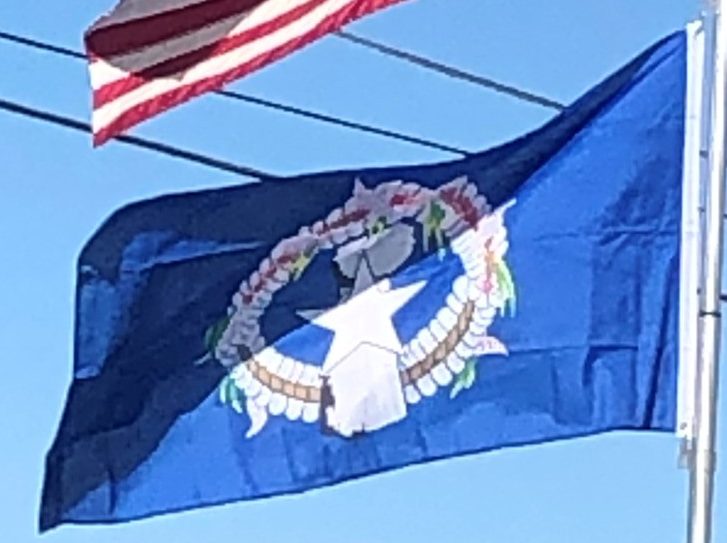In 1734, the Spanish built a royal palace in Guam for the governor of the islands. Its remains are visible even in the 21st century as Plaza de España located in Hagåtña, Guam.

In 1668, Father Diego Luis de San Vitores renamed the islands Las Marianas in honor of his patroness the Spanish regent Mariana of Austria (1634–1696), widow of Felipe IV (reigned 1621–1655).
Most of the islands’ native population (90–95%) died from Spanish diseases or married non-Chamorro settlers under Spanish rule. New settlers, primarily from the Philippines and the Caroline Islands, were brought to repopulate the islands. The Chamorro population gradually recovered, and Chamorro, Filipino, and Refaluwasch languages and other ethnic differences remain in the Marianas.
During the 17th century, Spanish colonists forcibly moved the Chamorros to Guam, to encourage assimilation and conversion to Roman Catholicism. By the time they were allowed to return to the Northern Marianas, many Carolinians from present-day eastern Yap State and western Chuuk State had settled in the Marianas. Both languages, as well as English, are now official in the commonwealth.
Carolinian Immigration:
The Northern Marianas experienced an influx of immigration from the Carolines during the 19th century. Both this Carolinian subethnicity and Carolinians in the Carolines archipelago refer to themselves as the Refaluwasch. The indigenous Chamoro word for the same group of people is gu’palao. They are usually referred to simply as “Carolinians”, though unlike the other two monikers, this can also mean those who actually live in the Carolines and who may have no affiliation with the Marianas.

The conquering Spanish did not focus attempts at cultural suppression against Carolinian immigrants, whose immigration they allowed during a period when the indigenous Chamoro majority was being subjugated with land alienation, forced relocations and internment. Carolinians in the Marianas continue to be fluent in the Carolinian language, and have maintained many of the cultural distinctions and traditions of their ethnicity’s land of ancestral origin.
German Possession and Japanese LON Mandate:
Following its loss during the Spanish–American War of 1898, Spain ceded Guam to the United States and sold the remainder of the Marianas (i.e., the Northern Marianas), along with the Caroline Islands, to Germany under the German–Spanish Treaty of 1899. Germany administered the islands as part of its colony of German New Guinea and did little in terms of development.

Early in World War I, Japan declared war on Germany and invaded the Northern Marianas. In 1919, the League of Nations awarded all of Germany’s islands in the Pacific Ocean located north of the Equator, including the Northern Marianas, under mandate to Japan. Under this arrangement, the Japanese thus administered the Northern Marianas as part of the South Pacific Mandate. During the Japanese period, sugar cane became the main industry of the islands. Garapan on Saipan was developed as a regional capital, and numerous Japanese (including ethnic Koreans, Okinawan, and Taiwanese) migrated to the islands. In the December 1939 census, the total population of the South Pacific Mandate was 129,104, of whom 77,257 were Japanese (including ethnic Taiwanese and Koreans). On Saipan the pre-war population comprised 29,348 Japanese settlers and 3,926 Chamorro and Caroline Islanders; Tinian had 15,700 Japanese settlers (including 2,700 ethnic Koreans and 22 ethnic Chamorro).
World War II:
On December 8, 1941, hours after the attack on Pearl Harbor, Japanese forces from the Marianas launched an invasion of Guam. Chamorros from the Northern Marianas, which had been under Japanese rule for more than 20 years, were brought to Guam to assist the Japanese administration. This, combined with the harsh treatment of Guamanian Chamorros during the 31-month occupation, created a rift that would become the main reason Guamanians rejected the reunification referendum approved by the Northern Marianas in the 1960s.
